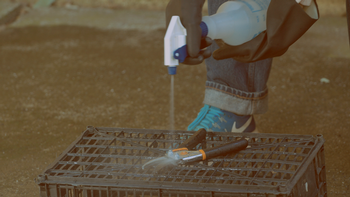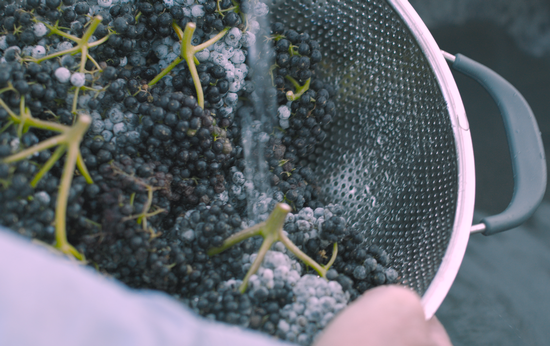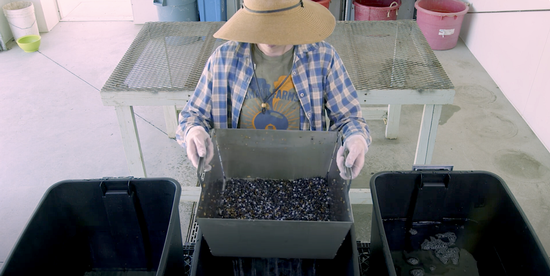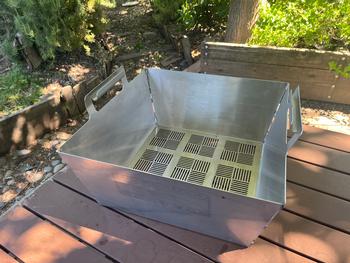Food Safety Best Practices: Elderberry Post-Harvest Handling
Estas viendo esta pagina en ingles. Si deseas verla en español, haz presiona aqui.
Introduction
In the first guide in this series, Food Safety Best Practices: Elderberry Harvest, we learned how to take steps to minimize food safety risks and thereby reduce the likelihood of foodborne illnesses during the harvesting process of Western blue elderberry (Sambucus nigra spp. cerulea) and elderflowers. In this guide, we outline food safety best practices for the next steps – post-harvest handling and washing – of elderberries destined for human consumption in the form of value-added products such as tea, syrup, juices, jelly, and jam. Because elderflowers undergo different post-harvest handling processes, we will provide guidance more specifically about elderberries in this guide. Other guides in the series include:
- Food Safety Best Practices: Elderberry Harvest
- Food Safety Best Practices: Elderberry Drying
- Food Safety Best Practices: Elderberry Freezing, Storage, and Holding
When handling and processing elderberries, we recommend considering the sequential steps you will follow to take elderberries from harvest to end product. Figure 1 offers possible pathways for elderberries through common post-harvest handling steps. This guide summarizes best practices for washing and destemming elderberries to prepare them for preservation methods such as freezing, drying, and processing, with an emphasis on food safety considerations.

A note on elderflowers: The food safety best practices guides primarily focus on elderberry fruit rather than elder flowers. In the case of post-harvest handling, the same food safety principles apply for maintaining a cleaned and sanitized post-harvest processing area, while the methods for washing and destemming elderberries do not apply to elderflowers.
Food Safety in Post-Harvest Handling
In post-harvest handling areas, elderberry growers should maintain minimum food quality and food safety standards in order to reduce the risk of physical, chemical, and biological contamination, and document their practices in the form of Standard Operating Procedures (SOPs), a set of instructions for conducting operational tasks on a farm or facility. Implementing food safety best practices can help ensure that elderberries and elderflowers are of consistent quality and food safety risks introduced through post-harvest handling are minimized. Below is a summary of select best practices for elderberry post-harvest operations. These key practices are important to consider when building a food safety program for your elderberry post-harvest handling operation and should be implemented alongside best practices introduced in Food Safety Best Practices: Elderberry Harvest.
Handwashing
- Handwashing stations should be available for all individuals before, during, and after post-harvest handling activities and must be stocked with running water, soap and individual paper towels or an electric hand dryer.
- Handwashing signs or reminders near handwashing stations reinforce proper handwashing procedures (Figure 2).

You can also view or download this information as a PDF document; click here for the Food Safety Best Practices: Elderberry Post-Harvest Handling guide.
pH levels in Western blue elderberry
Fruit with a pH of 4.6 or below is considered to be a high acid food that can be safely processed using a water bath canning method. In a study of five farm sites around Davis, California, the pH of blue elderberry was found to be below 4.6, with a mean of 3.66 ± 0.12 (Uhl et al., 2022). This is slightly lower than pH levels that have been shown for both American black elderberry (Sambucus nigra spp. canadensis) and European black elderberry (Sambucus nigra ssp. nigra).
Post-harvest water
Post-harvest water may be used in the following ways:
- Washing harvested elderberries
- Removing stems, leaves, or other debris from elderberries
- Cleaning and sanitizing food contact surfaces
- Handwashing
Depending on the water source, different testing, documentation, or use requirements are in place to ensure that water used for post-harvest handling operations meets the minimum standard of no detectable generic E. coli per 100 mL of water.
Well water: test four times a year in the initial year of testing to ensure no detectable generic coli criteria is met and keep results on file. Test once a year thereafter.
Public water: keep on file either of the following: (1) a copy of your public water system results on file, or (2) certificate of compliance that water meets the Safe Drinking Water Act.
Surface water: untreated surface water is not allowed to be used for post-harvest operations.
Toilets (bathrooms and portable toilet facilities)
- Readily accessible to all individuals who handle produce.
- Supplied with clean water, toilet paper, disposable single towels, and liquid hand soap.
- Regularly cleaned and sanitized.
- Human waste and toilet paper should be properly disposed of in the toilet.
- Stocked with a trash can receptacle with a lid.
For the Occupational Safety and Health Administration (OSHA) requirements for restrooms and sanitation, we recommend reviewing OSHA Restrooms and Sanitation Requirements.
Jewelry and hair
- No jewelry should be worn during post-harvest operations because the jewelry may fall off and introduce a physical hazard to harvested elderberries. Rings are generally allowed, unless the ring is difficult to adequately clean during handwashing.
- Hair should be restrained so that it does not end up in harvested products.
Clothing
- Clothing should be clean and not visibly soiled.
- When working with animals or handling raw manure, change clothing and footwear or use protective outer garments (e.g., aprons or coveralls) to be removed before moving to areas where elderberries are handled. Ideally, any handling of animals or raw manure should be done after handling produce.
- Clothing and other personal belongings, including lunch bags, should be stored in a designated area away from the harvested products to avoid cross-contamination.
Eating, drinking, and tobacco use
- These actions must be conducted in an area away from your post-harvest activities.
- After eating, drinking, or smoking, hands must be washed prior to re-engaging in post-harvest activities.
Facilities
- Buildings used for post-harvest handling are constructed and maintained in a manner to minimize food safety risks.
We recommend that your operation has a written food safety plan with SOPs and keeps documentation verifying that you are following the procedures laid out in the plan. For food safety plan templates, SOP templates, and examples of logs used for farm food safety recordkeeping, see the Community Alliance with Family Farmers’ Food Safety Plan Templates webpage.
Cleaning and Sanitizing
Elderberries can become contaminated when contacted by water, workers, and equipment during post-harvest handling activities. It is important to effectively and regularly clean and sanitize any surface that contacts the fruit, also called a food contact surface, to prevent contamination. Examples of food contact surfaces in elderberry post-harvest handling are:
- Buckets and totes used for harvesting and packing
- Conveyor belt
- Destemming surfaces
- Destemming equipment
- Tables
- Wash bins
 Figure 3. Tools and equipment used for harvest and post-harvest handling should be cleaned and sanitized. Photo by Ethan Ireland.
Figure 3. Tools and equipment used for harvest and post-harvest handling should be cleaned and sanitized. Photo by Ethan Ireland.
The following steps are recommended to clean and sanitize equipment:
- Pre-rinse by removing large particulate matter such as field soil, plant materials, and debris.
- Wash and scrub by applying detergent to equipment.
- Rinse equipment with clean water to clear away detergent and remaining soil.
- Sanitize equipment (Figure 3). Choose a sanitizer that is labeled for use on food contact surfaces. Mix and apply the sanitizer according to the instructions on the label.
The frequency of cleaning and sanitizing is at your discretion; however, the process and frequency needs to be outlined in an SOP. For a cleaning and sanitizing SOP example, see: Cleaning Harvesting Clippers SOP Sample, from the Community Alliance with Family Farmers.
A record should be maintained to document when and how cleaning and sanitation occurred. For a cleaning and sanitizing log example, see: General Cleaning and Sanitizing Log, from the Community Alliance with Family Farmers.
Because they can cause indirect contamination, non-food contact surfaces, such as floors, walls, and legs/sides of equipment should be cleaned regularly, though on a less frequent basis than food contact surfaces, and with periodic sanitation.
Growth niches, areas supporting a high level of microbial growth, can lead to the spread of environmental pathogens. Equipment made with sanitary design, meaning it is easy to clean and sanitize, can help reduce the risk of growth niches. The way equipment is assembled plays an important role in sanitary design. Exposed bolts, screws, welds, or holes can be challenging to effectively clean and/or sanitize. It is recommended to use equipment with parts that can be removed (not welded in place) to allow for separation during cleaning and sanitation. Additionally, equipment and tools should be made of a material such as stainless steel and food grade plastic, rather than wood and cardboard, which are porous and cannot be adequately cleaned and sanitized. Lastly, care and proper maintenance of equipment is critical as surfaces that become scratched or pitted can be difficult to clean and sanitize.
Guidance on Selecting Equipment with Sanitary Design
USE equipment that is:
- Easy to clean and sanitize.
- Made from materials that are smooth, durable, impervious, non-toxic, non-absorbent, non-reactive, non-contaminating and resistant to corrosion (e.g., stainless steel, food grade plastic) (Adhikari et al., 2022).
- Designed simply.
- Constructed with parts that can be removed or welded joints that are continuous and smooth (sanitary welds).
AVOID equipment that is:
- Difficult to clean and sanitize.
- Made of porous materials (e.g., wood, cardboard, fabric).
- Designed with exposed bolts, screws, welds, or any holes.
- Constructed with parts welded in place with sharp corners, bumps, and grooves prone to accumulating food material (unsanitary welds).
Post-Harvest Washing
Washing elderberries is an optional step in the post-harvest process that serves to remove debris from the product. Those washing their elderberries will need to consider the best washing system for their operation. All water used for post-harvest operations must have no detectable generic Escherichia coli per 100 mL of water (potable water) and no detectable levels of generic E. coli must be maintained in the water for the duration of its use. Operators may use either a single-pass or batch water washing method. Single-pass water (e.g. a spray stream of water) only contacts elderberries once and then is discarded. In contrast, batch water (e.g. a dunk tank) is reused multiple times prior to being discarded. The use of batch water presents the risk of spreading microorganisms between berries; adding sanitizer to batch water can help prevent cross-contamination.
Adding sanitizer to post-harvest wash water reduces the presence of microorganisms in the water but will not remove or inactivate foodborne pathogens on the elderberries. Instead, sanitizer helps to prevent cross-contamination between contaminated and uncontaminated elderberries and can lead to a safer product. Always be sure to select the appropriate sanitizer for your intended use – in this case, produce wash water – and mix and apply the sanitizer according to instructions on the label. For more information about selecting the appropriate sanitizer, we recommend the following resources from the Produce Safety Alliance:
Methods for Washing Elderberries
Four methods for washing elderberries are outlined below: (1) spray rinse, (2) spray rinse under a conveyor, (3) dunk tank wash with sanitizer, and (4) dunk tank triple wash with sanitizer. The method selected should be based on the scale of operation and available equipment.
Spray rinse (single pass):
- Remove any visible dirt from the elderberries.
 Figure 4. Elderberries are rinsed under water in a colander, a single-pass method recommended for small scale growers and handlers. Ethan Ireland.
Figure 4. Elderberries are rinsed under water in a colander, a single-pass method recommended for small scale growers and handlers. Ethan Ireland. - Discard bruised berries.
- Place elderberries in a clean colander or a food-grade screen elevated enough to prevent any splash-back from the floor. Be careful not to overload the colander or screen with berries.
- Rinse under cold, potable running water (Figure 4).
Advantages:
- Low-cost, simple method for small-scale elderberry processing.
- Berries are not submerged and running water carries away dirt and debris.
Disadvantages:
- Inefficient for large volumes of berries.
Spray rinse conveyor (single-pass):
- Place elderberries on a mechanical conveyor.
- The conveyor moves under spray heads which rinse the elderberries.
Advantages:
- Efficient system.
- Berries are not submerged and running water carries away dirt and debris.
Disadvantages:
- Conveyor system is expensive.
Single dunk tank wash with sanitizer (batch):
- Fill a food-grade tub or tote with potable water.
- Add an approved sanitizer to the water. Ensure that the sanitizer has an EPA label approving its use in produce wash water and use according to the instructions on the label.
- Place bulk elderberries in the tub or tote and gently agitate. Elderberries can be dunked by individual cymes or by dunking a food-grade slotted or perforated basket holding a batch of elderberries into the water.
- Change the water at a predetermined frequency (according to your SOP) or as needed based on the level of residual sanitizer.
Advantages:
- More efficient than the triple wash system.
Disadvantages:
- Only provides one step for the removal of debris.
Dunk tank triple wash with sanitizer (batch):
In this system there are three separate dunk tanks used to wash produce (Figure 5). Elderberries can be dunked by individual cymes or by dunking a food-grade slotted or perforated basket holding a batch of elderberries into the water (Figure 6).
- Tank 1 is an initial wash to remove large debris from the berries. Add sanitizer to the water prior to adding berries. Ensure that the sanitizer has an EPA label that approves its use in produce wash water and follow instructions exactly.
 Figure 5. A dunk tank triple wash system uses sequential food-grade tubs to remove debris from, sanitize, and rinse elderberries. Ethan Ireland.
Figure 5. A dunk tank triple wash system uses sequential food-grade tubs to remove debris from, sanitize, and rinse elderberries. Ethan Ireland. - Tank 2 also has sanitizer added and is used to remove more debris and particulates.
- Tank 3 is used for a final rinse. It may not be necessary based on the amount of dirt and debris present on the elderberries. If a third tank is used, sanitizer should be added. However, due to removal of organic material in tanks 1 and 2, a lower amount of sanitizer may be required to maintain a residual level of sanitizer in tank 3.
- Change the water at a predetermined frequency (according to your SOP) or as needed based on the level of residual sanitizer and turbidity of the water.
 Figure 6. Example of a stainless steel, perforated basket that can be used for batch-washing elderberries. Photo by UC SAREP.
Figure 6. Example of a stainless steel, perforated basket that can be used for batch-washing elderberries. Photo by UC SAREP.
Advantages:
- Triple washing can remove more dirt and debris compared to single washing.
Disadvantages:
- Triple wash systems require more infrastructure and higher volumes of water than single dunk tank systems (Blevins & Grubinger, 2012).
Notes on this method:
- The dunk tank method is not recommended to be carried out in a kitchen sink or other sink used for purposes other than washing elderberries. The sink, and drain in particular, can be sources of contamination. A bucket or tank constructed of food-grade material that can be fully emptied and sanitized is recommended for the dunk tank method.
- If using a slotted or perforated container to triple wash elderberries, use a clean sieve to skim debris off the surface of water so debris does not stay mixed in with elderberries.
In the case of dunk tank methods, it is important to monitor the turbidity or cloudiness of the water, as well as the buildup of organic matter (dirt, stems, leaves, and other debris), and change out the water at regular intervals. The organic load can greatly impact the efficacy of sanitizers added to the water. Develop standards for measuring water clarity as a way to monitor turbidity. The concentration of the sanitizer also needs to be monitored. This can be done using simple test strips or more complex equipment. Make sure to use the correct type of test strips for the sanitizer you are using. Chlorine based products (e.g. germicidal bleach) require free chlorine test strips, not total chlorine test strips. Peracetic acid (PAA) sanitizer products require PAA parts per million test strips. Follow the recommended guidelines for sanitizer levels in produce wash water according to the sanitizer you are using and adjust levels as needed to ensure the sanitary quality of water is maintained. Additionally, a tub or tank that is made of food-grade material and can easily be emptied and sanitized is recommended. Using light- instead of dark-colored tubs may make it easier to monitor turbidity and organic matter in the water.
Destemming Elderberries
All parts of elderberry plants can contain a cyanogenic glycoside called sambunigrin, a toxic precursor compound that can cause gastrointestinal upset when chewed or ingested (Senica et al., 2016; Sidor and Gramza-Michalowska, 2015). Higher concentrations of cyanogenic glycosides are found in stems, leaves, and unripe (green) berries (Appenteng et al., 2021), which is why it is advised to exclude these before and during any processing activities (Uhl and Mitchell, 2024). Since elderberry stems contain sambunigrin, it is important to destem elderberries before processing and consumption.
Outlined below are several elderberry destemming methods: (1) manual destemming, (2) manual destemming using screens, (3) freezing prior to manual destemming, and (4) mechanized destemming using an elderberry destemming machine. The destemming method should be selected based on scale of operation and available equipment.
Manual destemming
As cymes are harvested, they are knocked against the side of the harvesting bin. Ripe berries will release from the stem and fall into the harvesting bin, while unripe berries remain attached to the stem. This method may result in bruising or splitting of some berries. Alternatively, fresh berries can be removed after harvest by using a fork or fingers to remove them from the stems.
Manual destemming using screens
Screens or perforated stainless steel screens with pores (holes) larger than the diameter of the elderberries can be used to assist in destemming. Harvested cymes are placed in the screens and are shaken and rubbed on the screen to release berries that pass through the pores into a harvesting bin (Figure 7).

Freezing prior to manual destemming
Cymes of ripe elderberries are placed in food grade plastic bags or on cookie trays, stems facing up, and placed in a freezer. Once frozen, the berries can be rapidly removed from the stems by rubbing or shaking (Figure 8).

Mechanized destemming using an elderberry destemming machine
Some in the elderberry industry have built customized elderberry destemming machines. One portable model includes a “shaking” destemming method and a three-bay dunk tank system for washing and sorting. Another involves a modified grape destemmer, accomplished by removing one of the crushing wheels, installing a mesh basket, and reducing the speed. Always ensure that any equipment used for processing can be properly cleaned and sanitized.
For hand destemming, we recommend freezing the elderberries prior to manual destemming, as this proved the quickest method in an informal trial. Frozen elderberries came off the stems more easily and stayed intact better than fresh elderberries. Regardless of the destemming method, it is important to thoroughly inspect elderberries after destemming to remove green berries and any remaining stem or leaf material prior to processing (Figure 9).

Conclusion
In conclusion, implementing food safety best practices for destemming and washing elderberries is important for overall food safety and quality of elderberry end products. A critical component of these best practices is cleaning and sanitizing food contact and non-food contact surfaces to prevent cross-contamination of pathogenic microorganisms. Cleaning and sanitizing SOPs should be developed and recordkeeping measures implemented to ensure compliance with food safety standards. Monitoring and managing the quality of post-harvest water with testing, sanitizers, and proper procedures can help minimize the risk of contamination, and thus foodborne illness. To learn about next steps for food-safe handling of elderberry fruit and flowers, read the next guides in the series, Food Safety Best Practices: Elderberry Drying and Food Safety Best Practices: Elderberry Freezing, Storage, and Holding.
Resources
CLEANING & SANITATION
Cleaning and Sanitizing Farm Tools and Equipment. New Mexico State University.
Food Contact Surfaces. New Mexico State University.
ELDERBERRY DESTEMMING
Elderberry Farming - Destemming and Washing Berries. Buehler Organics.
The Ocooch Mountain Rotary Destemmer for Elderberries.
ELDERBERRY INFORMATION & BEST PRACTICES
California Elderberries: Harvesting, Processing & Marketing. University of California Sustainable Agriculture Research and Education Program (UC SAREP), UC Agriculture and Natural Resources.
FOOD SAFETY TEMPLATES
Food Safety Plan Templates. Community Alliance with Family Farmers.
POST-HARVEST WASHING & SANITATION
Best Practices for Washing Produce and Use of Sanitizers on Commercial Farms. University of Maine Cooperative Extension.
Farm Food Safety: Building an Easy Clean Produce Wash Table. Cornell University Cooperative Extension.
Food Safety Considerations for Postharvest Washing of Produce and Sanitation of Packing Areas. Washington State University Extension.
On-Farm Decision Tree Project: Postharvest Water.
Postharvest Chlorination: Basic Properties and Key Points for Effective Disinfection. University of California Division of Agriculture and Natural Resources.
Produce Safety Study Report: Effectiveness of Multiple Washings and/or Organic Sanitizer Treatment in Reducing E. coli Levels in Leafy Greens Wash Water. University of Vermont Extension.
Sanitary Design and Construction of Food Equipment. University of Florida Cooperative Extension Service, Institute of Food and Agricultural Sciences.
PRODUCE FOOD SAFETY COMPLIANCE
Current Good Manufacturing Practice (CGMP) Checklist. University of New Hampshire Extension.
Good Manufacturing Practices. Cornell College of Agriculture and Life Sciences.
References
Adhikari, A., Kharel, K., and Fontenot, K. (2019). Wash Water Chlorine Disinfection: Best Practices to Ensure On-Farm Food Safety. Louisiana State University Agricultural Center. Retrieved April 1, 2024.
Adhikari, A., Gupta, P., Aryal, J., & Lituma, I. (2022). Sanitary Design of Equipment for Food Processing. Louisiana State University Agricultural Center. Retrieved April 23, 2024.
Appenteng, M. K., Krueger, R., Johnson, M. C., Ingold, H., Bell, R., Thomas, A. L., & Greenlief, C. M. (2021). Cyanogenic Glycoside Analysis in American Elderberry. Molecules (Basel, Switzerland), 26(5), 1384.
Blevins, L., & Grubinger, V. (2012). Effectiveness of Triple Washing or Organic Sanitizer Treatment in Reducing E.coli Levels in Leafy Green Wash Water and its Relationship to Incoming E. coli load. University of Vermont Extension. Retrieved March 25, 2024.
Senica, M., Stampar, F., Veberic, R., Mikulic-Petkovsek, M. (2016). Processed elderberry (Sambucus nigra L.) products: A beneficial or harmful food alternative? LWT - Food Science and Technology, 72, 182–188.
Sidor, A. and Gramza-Michalowska, A. (2015). Advanced research on the antioxidant and health benefit of elderberry (Sambucus nigra) in food – a review. Journal of Functional Foods 18, 941–958.
Uhl, K.R., Fyhrie, K.J., Brodt, S.B., Mitchell, A.E. (2022). Blue Elderberry (Sambucus nigra ssp. cerulea): A Robust and Underutilized Fruit for Value-Added Products. ACS Food Sci. Technol, 2 (2), 347-358.
Uhl, K., & Mitchell, A. E. (2024). Elderberry, An Ancient Remedy: A Comprehensive Study of the Bioactive Compounds in Three Sambucus nigra L. Subspecies. Annual review of food science and technology.
_________
August 2024
Authors: Alicia Baddorf, Gwenaël Engelskirchen, Kristen Farrar (UC Sustainable Agriculture Research & Education Program); Erin DiCaprio, Thais Ramos, Ruofen Liao, Isabella Tosta (University of California Davis Department of Food Science & Technology)
Reviewers: Kali Feiereisel, Community Alliance with Family Farmers; Katie Reneker, Carmel Berry Company; Patrick Byers, University of Missouri Extension
This work was supported in part by the U.S. Department of Agriculture, National Institute of Food and Agriculture, Food Safety Outreach Program (award 2020-70020-33031). The information within has not been formally disseminated by the U.S. Department of Agriculture and should not be construed to represent any agency determination or policy.




